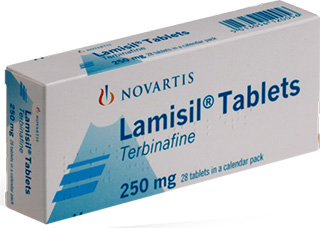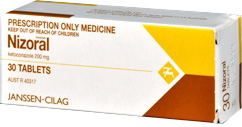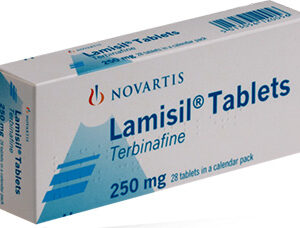Lamisil Overview
Lamisil, with the active ingredient terbinafine, is a widely-used antifungal medication. It belongs to the category of antifungal agents, specifically designed to combat various types of fungal infections. As an allylamine antifungal, Lamisil works by inhibiting the enzyme squalene epoxidase, which is a key component in the fungal cell membrane biosynthesis. This action leads to an accumulation of squalene within the fungal cell and ultimately causes cell death, providing effective relief from the infection.
Indications
Lamisil is primarily prescribed for the treatment of fungal skin infections such as tinea pedis (athlete’s foot), tinea corporis (ringworm), and tinea cruris (jock itch). Additionally, it can be used to manage onychomycosis, which is a fungal infection of the nails. Its efficacy lies in its ability to eliminate the causative organisms, restoring the health and integrity of skin and nails.
Dosage & Administration
The appropriate dosage of Lamisil can vary based on the condition being treated and the specific patient characteristics. Lamisil tablets are often prescribed as a once-daily regimen, with the length of treatment ranging from 6 weeks for fingernail infections to 12 weeks for toenail infections. The oral granules are sprinkled on food for children with scalp hair infections. It is essential to adhere to the recommended dosage and duration of treatment to prevent recurrence of infection. For topical formulations, which include cream, gel, and spray, the application typically involves covering the affected area once or twice daily, according to the severity of the infection.
Contraindications
Use of Lamisil is contraindicated in individuals with a known hypersensitivity to terbinafine or any of the other components within the medication. Moreover, patients with chronic or active liver disease should avoid this medication due to the risk of serious hepatic injury. It is crucial to disclose all existing health conditions to a healthcare provider before starting treatment with Lamisil.
Drug Interactions
Lamisil can interact with several other medications, potentially altering their effects. For instance, it can increase the levels of drugs metabolized by the liver that are processed through the CYP2D6 enzyme system. It’s important for patients to inform their healthcare provider of all medications they are taking to ensure their current drug regimen will not be adversely affected by starting Lamisil. Some common drugs that may interact with Lamisil include antidepressants, beta-blockers, antiarrhythmic medications, and selective serotonin reuptake inhibitors (SSRIs).
Side Effects
Patients may experience a range of side effects while taking Lamisil. Common side effects include headache, gastrointestinal discomfort, rash, and pruritus. More serious but less frequent side effects include taste disturbances or loss, which usually resolves after discontinuation of treatment, and liver enzyme abnormalities. Immediately consulting a healthcare professional is imperative if severe side effects or signs of an allergic reaction occur.
Precautions & Warnings
Caution is advised when administering Lamisil to patients with a history of liver or kidney impairment as these conditions can affect the metabolism and excretion of the drug, potentially leading to toxicity. Patients should undergo a baseline liver function test prior to starting therapy and be monitored for any signs of hepatic dysfunction during treatment. Furthermore, Lamisil can cause or exacerbate subacute cutaneous lupus erythematosus (SCLE); patients who develop lesions should discontinue the medication and evaluate further treatment options.
Special Populations Safety
Pregnant women, nursing mothers, and pediatric patients require additional caution when using Lamisil. While there’s limited data on the use of Lamisil in pregnant women, it should only be used if the potential benefits justify the risks. Terbinafine is excreted in breast milk and the impact on the nursing infant is unknown, hence it’s advisable to discontinue nursing or the drug, taking into account the drug’s importance to the mother. Safety and efficacy in pediatric patients for the oral formulation has not been established, except for the treatment of scalp ringworm, which utilizes oral granules.
Overdose & Measures
An overdose of Lamisil could result in headache, nausea, dizziness, and abdominal pain. In such situations, symptomatic supportive therapy should be initiated. Immediate medical attention is critical and patients should be observed closely; if necessary, gastric lavage or charcoal administration may be performed as emergency measures within the first few hours of ingestion.
Storing Lamisil
To maintain Lamisil’s effectiveness, it’s important to store the medication at room temperature away from moisture and heat. Tablets should be kept in their original packaging until use, and out of reach of children and pets. Discarding any unused or expired medication safely and responsibly is encouraged to prevent accidental ingestion.
Patient Counseling
Patients being prescribed Lamisil should be guided on the importance of completing the entire course of therapy, even if symptoms improve before the medication is finished. They should also be instructed on the signs of liver dysfunction, including unexplained persistent nausea, decreased appetite, fatigue, vomiting, right upper belly pain, jaundice, dark urine or pale stools, and should be directed to seek medical attention should these symptoms occur. Additionally, patients should report any other unusual symptoms or worsening of their condition to their healthcare provider.




Reviews
There are no reviews yet.